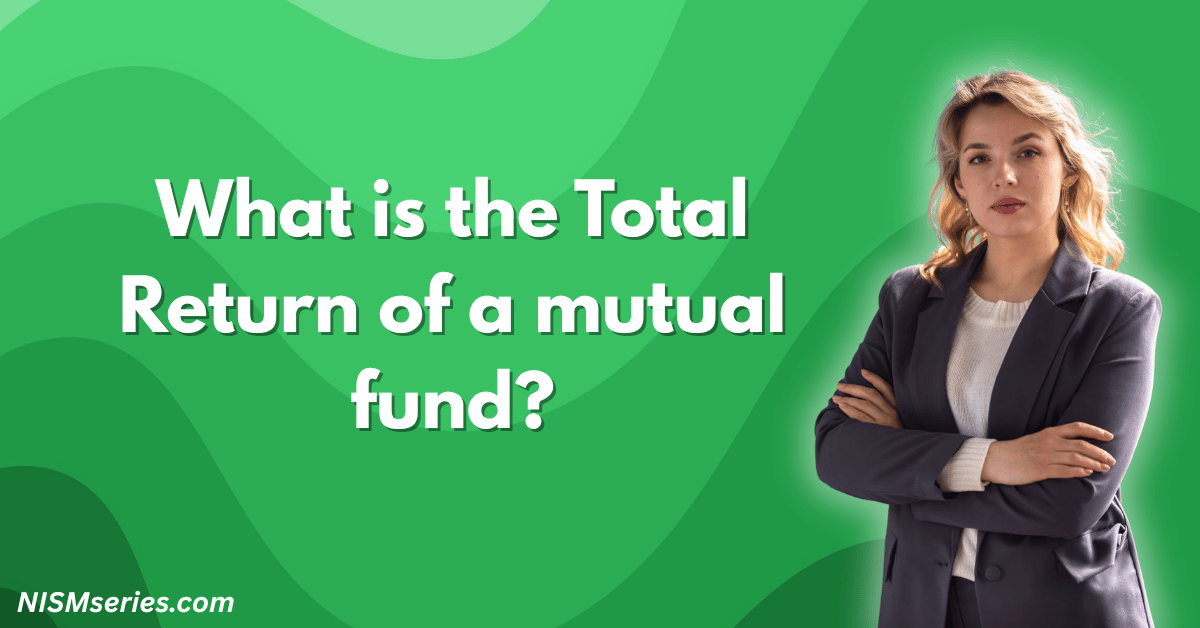Total Return is the only real way to check how your fund is doing. It shows you the whole picture. It includes the fund’s price going up and the money it pays you, like dividends. Just looking at the NAV is a big mistake. Total Return is the only number that really matters.
Total Return is the true money you earn from your mutual fund. It includes everything: interest, dividends, capital gains, and any changes in the NAV. It tells the full story of your investment. We show it as a percentage. It also includes all the money you get from the fund, which you should put back in.
Table of Contents
Understanding Total Return
Total Return shows you how much money your mutual fund truly made for you. It is not just about the price rising. It counts every rupee you get, like dividends. It gives you the complete story.
This is very important now. Last year, many equity mutual funds did very well. For example, one fund returned 25.59%. Another fund returned 25.44%. These numbers are the Total Returns, not just NAV changes. You must understand this is a very important difference.
What Does Total Return Mean for Investors?
For you, Total Return means the real money you get. If you invest ₹1 lakh, the Total Return shows the exact money you get back when you sell. This includes any payouts that were put back into your investment. This is the only way to know how well you really did.
Here is an example: a fund’s price goes up 15%. But it also paid you 3% in dividends. Your Total Return is 18%, not just 15%. You must always look at the big picture.
Total Return vs Other Return Metrics
Old ways to check returns are wrong. They will trick you. They only look at the NAV price. They do not count the money the fund pays you in dividends. This gives you a false idea of how the fund is doing.
Total Return fixes this big problem. It includes all your income. It is the only honest way to measure performance. You must use it when you compare different funds.
Capital Appreciation Component
This is the part of your return from the fund’s price going up. The stocks inside the fund become more valuable. This happens when the fund manager picks good stocks. In a good market, this is where most of your return comes from.
Income Distribution Component
This is the money the fund pays to you. It can be dividends from stocks or interest from bonds. The fund gives you this money from time to time. This is an important part of your Total Return.
Components and Calculation of Total Return
How is Total Return Calculated?
The math is simple: Total Return = [(Ending Value + Distributions) / Beginning Value – 1] × 100
This shows your whole investment story. For example, you invested ₹10,000. It grew to ₹12,000. You also got ₹500 in payments. Your Total Return is [(₹12,000 + ₹500) / ₹10,000 – 1] × 100 = 25%. This is your real return.
NAV Changes and Their Impact on Returns
When the NAV changes, it changes your Total Return. If the manager makes smart choices, the NAV goes up, and you make more money. Bad choices make the NAV go down. For example, one fund returned 28.45% a year for three years. This shows how a growing NAV makes your Total Return bigger.
Dividend and Capital Gains Distribution
Mutual funds give you money from what they earn. These payments are called dividends and capital gains. This is real money for you. It is a key part of your Total Return.
Reinvestment of Distributions
The smartest thing you can do is reinvest these payments. This means the money is used to buy more units of the fund for you. This makes your money grow much faster over many years. This is the only way to build great wealth.
Tax Implications on Total Return
You must know that you have to pay tax on all dividend money. How much tax you pay depends on how much you earn. There are different tax rules for capital gains. These taxes will make your final Total Return a little lower.
Types of Total Return Measurements
Absolute Return vs Total Return
Absolute Return is not a useful number. It only tells you how much the price changed. Total Return gives you the complete and true measure of performance. You must always use Total Return to compare funds.
Annualized Total Return (CAGR)
CAGR tells you the average return you get each year. It makes it simple to compare funds, even if you held them for different amounts of time. Some funds had great returns over the last three years. We use CAGR to compare them in a fair way.
How Does Total Return Index (TRI) Work?
A TRI is a type of benchmark. A benchmark is something you compare your fund to. The TRI acts as if all dividends from the stocks inside it are put back in. This makes it a very good and real thing to compare your fund against.
TRI vs Price Return Index (PRI)
The difference between a TRI and a PRI is very big over time. For example, over 5 years, one index (a PRI) grew 11.77% a year. The TRI version of that same index grew 13.33% a year. The extra 1.56% is because of dividends. You must always look at the TRI.
SEBI Mandate for TRI Benchmarking
In 2018, SEBI made a very good rule. It said all mutual funds must compare their performance to a Total Return Index (TRI). This rule makes funds be honest. It makes sure the comparison is fair.
Why Total Return Matters for Fund Performance
Accurate Performance Measurement
Total Return is the only accurate way to measure. A fund that pays a lot of dividends might look like it’s doing badly if you only see its NAV. But its Total Return will show you the true, successful story.
Investment Decision Making Benefits
You will make better choices when you use Total Return numbers. When you compare two funds, one with a 24.64% return and another with 19.74%, these Total Return numbers let you make a true and honest comparison.
Long-term Wealth Creation Impact
If you want to build wealth, Total Return is the number that matters. It shows how much your money has really grown. A small dividend can become a lot of money over time. For example, over 5 years, dividends on a ₹1 lakh investment could add an extra ₹13,000 to your final amount. This shows why Total Return is so important.
FAQ
How do you calculate total return on a mutual fund investment?
To find the Total Return, you add all the payments you got to the final value. Then, you divide by the money you started with and subtract one. To make it a percentage, you multiply by 100. You must include any money that was reinvested to get the right number.
What is the difference between total return and absolute return?
Absolute Return only looks at the change in price. It is not a good number because it forgets about dividends. Total Return includes all the money you get and gives you the real picture of how your fund did. The difference is very important for funds that pay dividends.
Why is total return more accurate than NAV-based returns?
Returns based only on NAV are wrong. They do not count dividend payments. Total Return includes everything. It shows you how much money you truly made. This is the only way you can make smart choices about your investments.
How does dividend reinvestment affect total return?
When you reinvest dividends, your money grows much faster. This is called compounding. The money you reinvest buys more units of the fund. Then, these new units also start earning returns for you. This is how you build real wealth over many years.
What role does Total Return Index play in fund benchmarking?
The TRI is the only fair benchmark. It measures a fund’s performance in an honest way. It includes dividends, just like a fund’s Total Return. The rule from SEBI that makes funds use the TRI helps make sure that all comparisons are fair.



















